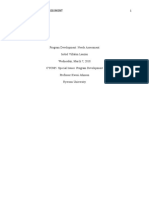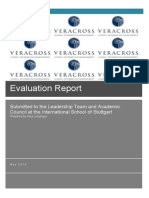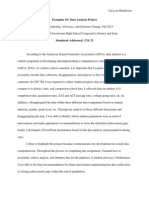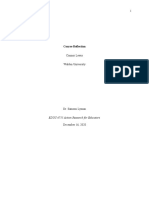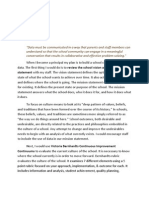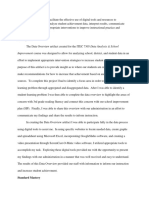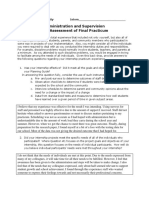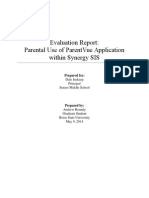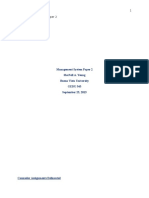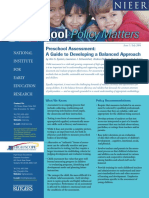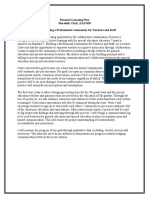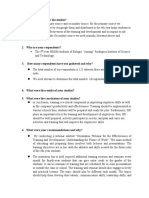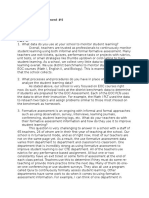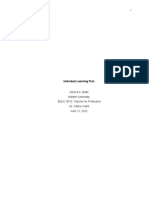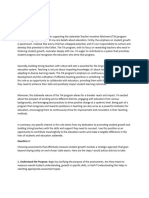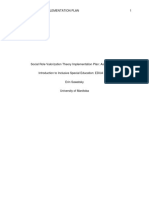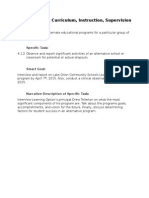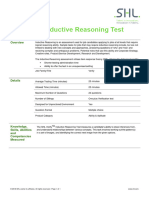Competency 2 Account
Competency 2 Account
Uploaded by
api-283430825Copyright:
Available Formats
Competency 2 Account
Competency 2 Account
Uploaded by
api-283430825Original Title
Copyright
Available Formats
Share this document
Did you find this document useful?
Is this content inappropriate?
Copyright:
Available Formats
Competency 2 Account
Competency 2 Account
Uploaded by
api-283430825Copyright:
Available Formats
Competency 2: Accountability
Related Task:
1.4 Ability to assess the effectiveness of an instructional program.
Narrative of Task:
1.4.4 Work with a district committee to conduct a district-wide assessment of
the effectiveness of the instructional program.
Smart Goal:
Collect reading program data by March 27th, and complete evaluation prior to
April 1st.
Narrative Description:
Starting the 2014-2015 school year Waldon Middle School was labeled as a
Title I school. As a result Waldon will receive Title I funds to upgrade the
entire educational program of the school. These funds are earmarked for
school wide or targeted assistance programs in order to help disadvantaged
children meet high academic standards. Accompanying Title I funds is an evaluation
of the program/strategy/initiative that the funds were used for.
For the 2014-2015 school year all three middle schools in the Lake Orion
Community School District were labeled as Title I. Since all three middle schools
used the same programming and strategies I worked with each building principal to
evaluate the effectiveness of the program.
At Waldon Middle School the funds received from Title I were used for staffing two
curriculum support programs. The At-Risk curriculum support class was used assist
students that were struggling to meet academic standards in all core subject areas.
When identified, a student would be placed in the curriculum support class with a
Title I funded staff member for one class period each day.
Title I funds also provided for an additional staff member to be placed in the reading
support classes. Sixth and Seventh grade students identified as being below grade
level in reading fluency or comprehension would be placed in the support class
where strategies, such as I-Ready, would be used to target and grow areas of
weakness that students had in reading.
To evaluate the effectiveness of the program I was given a packet of questions from
the State of Michigan. Upon reviewing the questions with my principal it became
clear that I needed to identify data that would show the effectiveness of the
program. My search for data began with having conversations with the staff
members whose positions are funded through Title I.
As a result of my conversations with staff members on what type of data is kept I
narrowed the scope of my focus upon reading fluency and comprehension. I found
out that beginning of the year screeners are administered in order to identify
students who are below grade level. After a series of steps are taken and permission
granted, they are placed in a reading support program. The reading program then
administers additional reading screeners for the tracking growth while in the
program. As a result I was able to use Fall screener data in comparison to Winter
screener data to gauge the effectiveness of the program.
Once I obtained the reading data from staff members I used percentages to show
how many students participating in the program demonstrated growth between
from the fall to winter testing dates. At that point I disaggregated the data further to
show how much of a percent increase each student who had growth showed. By
placing the percent range increases into a pie chart I was able to identify a pattern
within the small sample size that I had.
To finalize the evaluation I answered the questions posed by the State of Michigan
using the aggregated data I now had available to me as the evidence needed to
show effectiveness. At that point I also have to answer questions about
administrative practice in relation to the operation of the programs. For this section
I sat down with my building principal to review actions and steps that he has taken
to ensure program integrity.
Specific
Meet with reading program staff and my building administrator to
identify and collect data that would allow us to evaluate the
program and show effectiveness.
The data collected will be disaggregated to show student growth
and ultimately program effectiveness.
Measurable
The reading program currently collects beginning of the year data
and administers intermittent growth assessments to track student
progress. The data will simply need to be collected and
disaggregated to fulfill the requirements set by the State for Title I
Attainable
funded schools.
Relevant
Currently collecting the data will fulfill the evaluation requirement
set by the State. However, collecting this data can also provide an
effective means to compare our current reading program to last
years reading program to determine which program was more
effective.
Timely
For the 2014-2015 school year Waldon Middle School is required
by the State of Michigan to complete an evaluation of the
program/strategy/initiative that was funded through Title I
Reflection:
During my clinical practice I have both been able to gain a wide range of
skills as well as further develop the skill set that I have. Specifically,
throughout the process of selecting and completing a competency on
accountability I have encountered several administrative revelations. The
moments I am referring to range from the continued importance of
relationship building, to interpersonal skills, data disaggregation, and
purposeful data usage.
After developing a plan of action with my administrator I shortly thereafter
had my first moment of clarity. To carry out the evaluation I needed to speak
to reading program staff about compiling currently available data in order to
show that the reading program we offer is effectively meeting the needs of
our students. Upon having conversations with staff members regarding the
next steps of the evaluation, I immediately felt a sense of discomfort. The
discomfort that was prevalent throughout the next couple of weeks was not a
sense of uneasiness with me, since I had a positive working relationship with
each individual, but instead the purpose of the collection. It became evident
to me that this process was unfamiliar to them as a result of previous years
not being required to present the data in this form. It was also evident to me
that a conversation explaining that the process was not in place to harm
them had not occurred. It was not until I recognized the issue and explained
the intent that I got the data that was needed.
Upon entering education, my answer to the interview question on the
importance of data was that it is effective in identifying where students are
proficient and what areas need to be targeted. I have learned a lot since is
then, while my original answer is correct, data is far more valuable that I
originally understood. In education have observed that data is everywhere,
however purposeful and effective data disaggregation and usage is the
exception, not the rule. As a leader of an organization I believe that it is
paramount to have training and meetings on the proper usage and potential
benefits of data collection. Unfortunately, we have become well versed in
data collection, but are relatively inexperienced beyond that point. As a
result educators are aware of the lack of disaggregation and as a result the
awareness subconsciously or consciously impacts the collection process. If a
foundation in regards to data collection is effectually laid its usage will
produce a more efficient organization.
You might also like
- Sustaining ImprovementDocument6 pagesSustaining Improvementapi-520679261100% (1)
- Performance AnalysisDocument9 pagesPerformance Analysisapi-332693679100% (1)
- Needs Assessment - Villalon LauzonDocument8 pagesNeeds Assessment - Villalon LauzonIsobel V LauzonNo ratings yet
- Veracross Evaluation Report - finalISSDocument40 pagesVeracross Evaluation Report - finalISSAnja JungingerNo ratings yet
- Job Description - Teacher of EnglishDocument4 pagesJob Description - Teacher of EnglishmnamkyNo ratings yet
- Pathophysiology and Psychodynamics of Disease Causation, Homeostatic Mechanism, Life ProcessesDocument13 pagesPathophysiology and Psychodynamics of Disease Causation, Homeostatic Mechanism, Life ProcessesMeenu Dogra70% (10)
- Capstone Portfolio Standard Reflection Standard 6Document2 pagesCapstone Portfolio Standard Reflection Standard 6api-279619064No ratings yet
- Competency 6Document3 pagesCompetency 6api-272929905No ratings yet
- Exemplar 1Document4 pagesExemplar 1api-315905890No ratings yet
- Exemplar 2Document3 pagesExemplar 2api-252309583No ratings yet
- Measure - ElmwoodDocument5 pagesMeasure - Elmwoodapi-257829203No ratings yet
- 6 Reasons It's Important To Create Your Own Online AssessmentsDocument3 pages6 Reasons It's Important To Create Your Own Online AssessmentsSaliza ShamsudinNo ratings yet
- MD6Assgn Lewisc CDocument7 pagesMD6Assgn Lewisc CConnor LewisNo ratings yet
- Sample - Raise Achievement of Yr 11Document20 pagesSample - Raise Achievement of Yr 11api-344945420No ratings yet
- Advocacy PlanDocument5 pagesAdvocacy PlanjdkoontzNo ratings yet
- Cspel 2 Narrative SummaryDocument5 pagesCspel 2 Narrative Summaryapi-377039370No ratings yet
- Data Board InquiryDocument16 pagesData Board InquirylynjonesNo ratings yet
- Competency 1Document4 pagesCompetency 1api-235142108No ratings yet
- Goal 1-Cspel 1Document5 pagesGoal 1-Cspel 1api-377039370No ratings yet
- Iready Program EvaluationDocument2 pagesIready Program Evaluationapi-313620882No ratings yet
- Schlumpf Data Culture PlanDocument4 pagesSchlumpf Data Culture PlanGlenn E. Malone, Ed.D.No ratings yet
- Report of Early Childhood Professionals' Views of AssessmentDocument15 pagesReport of Early Childhood Professionals' Views of Assessmentapi-385499627No ratings yet
- Alfonso Amy Reflection Standard2.8Document3 pagesAlfonso Amy Reflection Standard2.8ah2maxNo ratings yet
- Ead 510 - Clinical Field Experience B - Schoolwide Budgetary NeedsDocument6 pagesEad 510 - Clinical Field Experience B - Schoolwide Budgetary Needsapi-578761151No ratings yet
- 2.8 Data AnalysisDocument2 pages2.8 Data Analysisapi-405559723No ratings yet
- Self Assessment of Final PracticumDocument3 pagesSelf Assessment of Final Practicumapi-417544594No ratings yet
- Self Assessment of Final PracticumDocument3 pagesSelf Assessment of Final Practicumapi-317126601No ratings yet
- Practicumreflection 4Document6 pagesPracticumreflection 4api-354960279No ratings yet
- Proficiency 5Document2 pagesProficiency 5api-508196283No ratings yet
- Educator Evaluation Newsletter August 2014Document3 pagesEducator Evaluation Newsletter August 2014Patrick LarkinNo ratings yet
- Roundy Evaluation ReportDocument13 pagesRoundy Evaluation ReportroundyaNo ratings yet
- Management System Paper 2Document8 pagesManagement System Paper 2api-340244643No ratings yet
- 4 ReflectionDocument3 pages4 Reflectionapi-284061543No ratings yet
- Professional Growth PlanDocument3 pagesProfessional Growth Planapi-371997193No ratings yet
- Preschool Assessment: A Guide To Developing A Balanced ApproachDocument12 pagesPreschool Assessment: A Guide To Developing A Balanced Approachsuji1974No ratings yet
- Teacher Leader Project CabralDocument17 pagesTeacher Leader Project Cabralapi-678707581No ratings yet
- Reflection 3Document2 pagesReflection 3api-288004986No ratings yet
- Is It Working in Your Middle School?: A Personalized System to Monitor Progress of InitiativesFrom EverandIs It Working in Your Middle School?: A Personalized System to Monitor Progress of InitiativesNo ratings yet
- Class Literacy PlanDocument5 pagesClass Literacy Planapi-188144621No ratings yet
- Narrative Reflections AssignmentsDocument6 pagesNarrative Reflections Assignmentsapi-245889774No ratings yet
- Personal Learning PlanmsuDocument3 pagesPersonal Learning Planmsuapi-122765129No ratings yet
- Professional Development SummariesDocument8 pagesProfessional Development Summariesapi-484204146No ratings yet
- Phase III 615 Fall2013Document6 pagesPhase III 615 Fall2013tenNo ratings yet
- Summative Example - ProficientDocument4 pagesSummative Example - Proficientkayse abtidoonNo ratings yet
- Electronic Portfolio-A Sample School Improvement PlanDocument5 pagesElectronic Portfolio-A Sample School Improvement Planapi-251656342No ratings yet
- Standard 5 ReflectionDocument2 pagesStandard 5 Reflectionapi-315190146No ratings yet
- AnswersDocument4 pagesAnswersNacion Chenee Kate B.No ratings yet
- C t898 Vitt 1d ArtifactDocument9 pagesC t898 Vitt 1d Artifactapi-546048435No ratings yet
- Early Childhood AssessmentDocument2 pagesEarly Childhood AssessmentSheeva AbenidoNo ratings yet
- Learning Outcomes Narrative - Areas For Development FinalDocument7 pagesLearning Outcomes Narrative - Areas For Development Finalapi-310924257No ratings yet
- Artifact 8 Updated 2Document4 pagesArtifact 8 Updated 2api-213157044No ratings yet
- Set BDocument9 pagesSet BSTA. FE NHS ICTNo ratings yet
- DLP Interim Assignment #4 Jenny O'Meara NELA Cohort 4 Assignment 4.2Document4 pagesDLP Interim Assignment #4 Jenny O'Meara NELA Cohort 4 Assignment 4.2api-284825601No ratings yet
- Child Study (Pre-Student Teaching)Document2 pagesChild Study (Pre-Student Teaching)MelomiJoyNo ratings yet
- Competency ReflectionsDocument10 pagesCompetency Reflectionsapi-392122158No ratings yet
- Brittni Kilpatrick Practicum Project - RTI Co-Facilitator Reason For ProjectDocument9 pagesBrittni Kilpatrick Practicum Project - RTI Co-Facilitator Reason For Projectapi-269169739No ratings yet
- MD 5Document6 pagesMD 5api-618740462No ratings yet
- FRIT 7739 Face To Face Staff DevelopmentDocument26 pagesFRIT 7739 Face To Face Staff DevelopmentbookwormjoeyNo ratings yet
- Action Research ReflectionDocument5 pagesAction Research Reflectionapi-277207317No ratings yet
- Supplemental QuestionsDocument4 pagesSupplemental QuestionsAmanda WoodNo ratings yet
- SRV Assignment 4Document10 pagesSRV Assignment 4api-414986096No ratings yet
- Cbam SurveyDocument2 pagesCbam Surveyapi-283430825No ratings yet
- Cbam GraphDocument1 pageCbam Graphapi-283430825No ratings yet
- Competency 6cbamDocument7 pagesCompetency 6cbamapi-283430825No ratings yet
- Competency 4 Alt-EdDocument4 pagesCompetency 4 Alt-Edapi-283430825No ratings yet
- Reading DataDocument2 pagesReading Dataapi-283430825No ratings yet
- Competency 5Document5 pagesCompetency 5api-283430825No ratings yet
- Final ProposalDocument23 pagesFinal Proposalapi-283430825No ratings yet
- Project Execution ProblemsDocument10 pagesProject Execution ProblemsAishatu Musa AbbaNo ratings yet
- Volleyball Master PlanDocument4 pagesVolleyball Master Planapi-251232621No ratings yet
- Escultura SonoraDocument40 pagesEscultura Sonoradanielll17No ratings yet
- Esei PakkDocument7 pagesEsei PakkNik QistinaNo ratings yet
- Fps 0504Document4 pagesFps 0504Sharma ShikhaNo ratings yet
- Spatial Disorientation in AviationDocument12 pagesSpatial Disorientation in AviationT-CAS0% (1)
- Theories and Practice of Conflict ManangementDocument13 pagesTheories and Practice of Conflict ManangementJOSHUA ADINOYI VICTORNo ratings yet
- Effortless EnglishDocument67 pagesEffortless EnglishHà Thu HươngNo ratings yet
- WT1 SL CriteriaDocument1 pageWT1 SL CriteriaSPAMMMNo ratings yet
- Actual Letters of Support For RADocument18 pagesActual Letters of Support For RAYTOLeaderNo ratings yet
- Verify Inductive Reasoning Fact Sheet CGDocument1 pageVerify Inductive Reasoning Fact Sheet CGBryan OgenaNo ratings yet
- 12 Potent Acupressure Points To Cure VertigoDocument12 pages12 Potent Acupressure Points To Cure VertigoDexter HarperNo ratings yet
- CV VeeraBhadraDocument2 pagesCV VeeraBhadraAnish Kumar DhirajNo ratings yet
- Understanding Nietzsche's AestheticsDocument10 pagesUnderstanding Nietzsche's AestheticsRuel Benjamin BernaldezNo ratings yet
- Spjet Sample Paper No 2Document16 pagesSpjet Sample Paper No 2MinhChau HoangNo ratings yet
- I Turn To You LyricsDocument13 pagesI Turn To You LyricsLidia Dwi PutriNo ratings yet
- Ra 9344Document24 pagesRa 9344thedoodlbotNo ratings yet
- Some Definitions of Strategy and TacticsDocument15 pagesSome Definitions of Strategy and TacticskiranaishaNo ratings yet
- Application LetterDocument2 pagesApplication LetterGeorgy Khalatov100% (1)
- Vcd643 (English) - BKDocument8 pagesVcd643 (English) - BKpbks.info100% (4)
- Mental Status ExaminationDocument35 pagesMental Status Examinationmob3No ratings yet
- Lesson Plan Template: Date Subject Number of Students GradeDocument4 pagesLesson Plan Template: Date Subject Number of Students Gradeapi-295505403No ratings yet
- The Ecstasy of Rita Joe Summary and Analysis of Act 1 FinalDocument36 pagesThe Ecstasy of Rita Joe Summary and Analysis of Act 1 FinaljsrheniusNo ratings yet
- ConsolidatedDocument17 pagesConsolidatedVitthal BelamkarNo ratings yet
- Art Craft: Mastery Learning Portfolio Tracking SheetDocument5 pagesArt Craft: Mastery Learning Portfolio Tracking Sheetapi-309191125No ratings yet
- Dissertation Proposal GuideDocument3 pagesDissertation Proposal Guideasma_christineNo ratings yet
- The Truth-Seeker's Handbook: A Science-Based GuideDocument53 pagesThe Truth-Seeker's Handbook: A Science-Based GuideJune Lyn100% (1)
- Essay Outline Template WordDocument3 pagesEssay Outline Template Wordafabfetiu100% (2)


